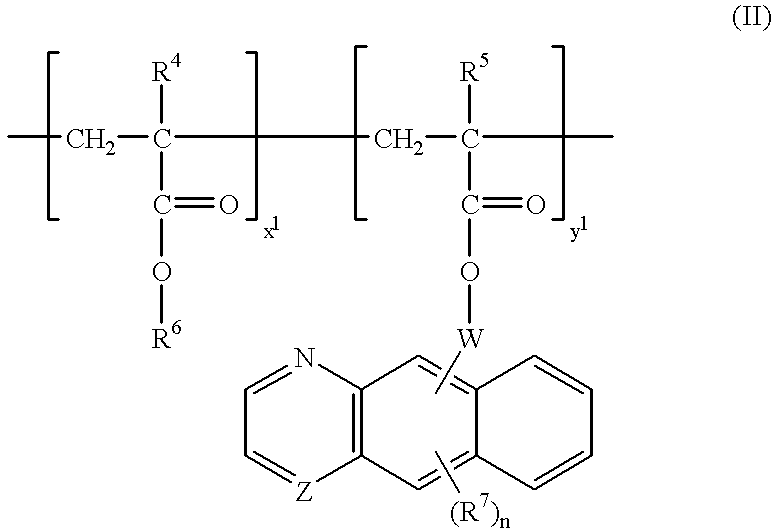High conformality antireflective coating compositions
- Summary
- Abstract
- Description
- Claims
- Application Information
AI Technical Summary
Benefits of technology
Problems solved by technology
Method used
Image
Examples
example 1
Preparation of high molecular polymers
Preferred polymers for use in ARCs of the invention can be prepared as follows.
Hydroxyethyl methacrylate (HEMA)Imethylanthracene methacrylate (ANTMA) copolymer (Formula I above) are suitably prepared by charging a 300 ml 3N round bottom flask equipped with magnetic stirrer, condenser, nitrogen and vacuum inlet with 16.0 g (0.1229 mol) HEMA (purified by distillation), 8.49 g (0.0307 mol) methylanthracene methacrylate, 0.2449 g (1 wt. %) AIBN and 180 ml THF. Other amounts of HEMA and ANTMA monomers can be suitably employed to provide HEMA / ANTMA copolymers having other HEMA and / or ANTMA units mole percents. The reaction flask is quenched in liquid nitrogen while being purged with nitrogen. When the contents of the reaction flask are frozen, the flask is evacuated, then purged with nitrogen (3 times). The reaction mixture is stirred under reflux until reaction completion, e.g. about 18 hours. The pale yellow polymer is precipitated into 3000 ml ethe...
example 2
Preparation and processing of ARCS of the invention
Six antireflective compositions of the invention (referred to as ARCs 1-6)were prepared by mixing the components set forth below, with component amounts pressed as parts by weight based on total weight of solids of the ARC. All the ARCs had the same components and amounts thereof, expect for the Resin binder component. ARC 1 had a resin binder component that consisted of Polymer 1; ARC 2 had a resin binder component that consisted of Polymer 2; ARC 3 had a resin binder component that consisted of Polymer 3; ARC 4 had a resin binder component that consisted of Polymer 4; ARC 5 had a resin binder component that consisted of Polymer 5; and ARC 6 had a resin binder component that consisted of Polymer 6.
Components of ARCs 1-6:
1) Resin binder: 86.4 weight % of one of Polymers 1-6
2) Crosslinker: 12 weight % Powderlink 1174 (American Cyanamid)
3) Thermal acid generator: 1.5 weight % p-nitrobenzyltosylate
4) Surfactant: 0.1 weight % FC-431 (3M...
PUM
 Login to View More
Login to View More Abstract
Description
Claims
Application Information
 Login to View More
Login to View More - R&D
- Intellectual Property
- Life Sciences
- Materials
- Tech Scout
- Unparalleled Data Quality
- Higher Quality Content
- 60% Fewer Hallucinations
Browse by: Latest US Patents, China's latest patents, Technical Efficacy Thesaurus, Application Domain, Technology Topic, Popular Technical Reports.
© 2025 PatSnap. All rights reserved.Legal|Privacy policy|Modern Slavery Act Transparency Statement|Sitemap|About US| Contact US: help@patsnap.com



